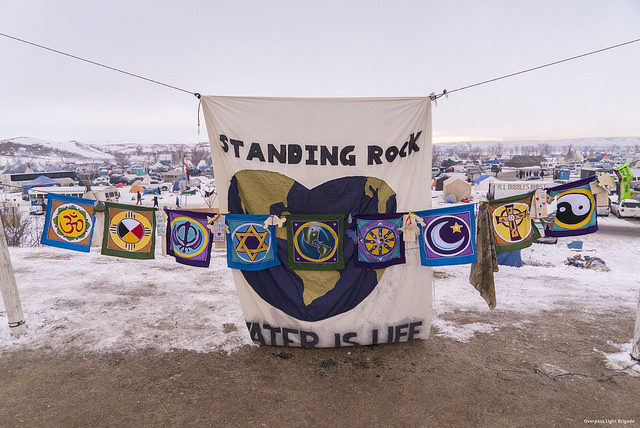Winter has descended on North Dakota, with biting snow and hard winds that buffet the Oceti Sakowin camp — the main protest camp near Cannon Ball, North Dakota, where the Standing Rock Sioux band, their Indigenous allies and U.S. veterans have been protesting against the 1,885-kilometre Dakota Access Pipeline.
The pipeline project had been complete but for a segment planned to run under Lake Oahe, a reservoir formed by a dam on the Missouri River.
It is this controversial dig that has concerned and angered water protectors who have descended by the hundreds to the Standing Rock reservation to create an activist camp to support their direct action, later backed by a call-out to U.S. military veterans who mobilized to protect the demonstrators from brutal police repression, including using water cannons when the temperature was already near or below freezing.
There were reports that after the December 5, 2016 blizzard that nearly paralyzed the camp with iced-over roads and a snow storm so fierce that you could barely see, that the camp had shut down. And yet, activists remain. And remain still as the weather continues to get colder. It is U.S.’s Winter on Fire, as activists gather to stop the $3.8-billion project, saying it could not only contaminate the water supply for a large area but also damage sacred tribal lands.
And I believe it is the fire in these activists’ hearts that will guide them through the winter. And I know a lot about winter. I am Saami, after all, and we have our own Reindeer Resistance to preserve the Arctic and our Indigenous land, Sapmi.
Regarding the Oceti Sakowin camp, it was before the December 5 blizzard that confusion settled over the camp as the word of the Standing Rock chief was either manipulated or misinterpreted.
In regards to the coming blizzard, Chief Dan George did not announce that the camp was shutting down completely and did not tell demonstrators to go home, he merely cautioned those who were not used to harsh winters to prepare accordingly — which might mean leaving the camp if they were ill-prepared.
There was no order to disband nor was there an edict that if you left the camp you could never come back. And yet that is the narrative that some right-leaning news outlets broadcast. When you don’t control the media, this kind of thing happens.
But I can say soundly that demonstrators are still at the camp, with camp/community helpers, sometimes riding on horseback when the pathways are too slick, going from tent to tent to do wellness checks and top up propane.
This is where the thousands of veterans — a count that has fluctuated between 2,000 and 5,000 service personnel — who came to the camp mattered most, as they had the logistical know-how to manage poor weather conditions, and it is their training linked with Indigenous knowledge of how to handle cold winters that has made all the difference and I am thankful for the support they are providing, just as I am thankful for those who shared their wisdom and oral history.
Yes, celebration erupted at the camp where it was announced that the U.S. Army Corps of Engineers has turned down a permit for a controversial pipeline — at least temporarily.
This does not mean that some activists are prepared to leave as they do not trust the news that the Army Corps of Engineers had denied the final easement to drill below the Missouri River, or more correctly, they don’t trust that Energy Transfer Partners, the Texas-based company behind the Dakota Access Pipeline, will honour the Army Corps’ decision.
Water protection is going to be critical as pipelines continue to snake across North America.
After all, it’s your water, too.
Photo: Joe Brusky/flickr




